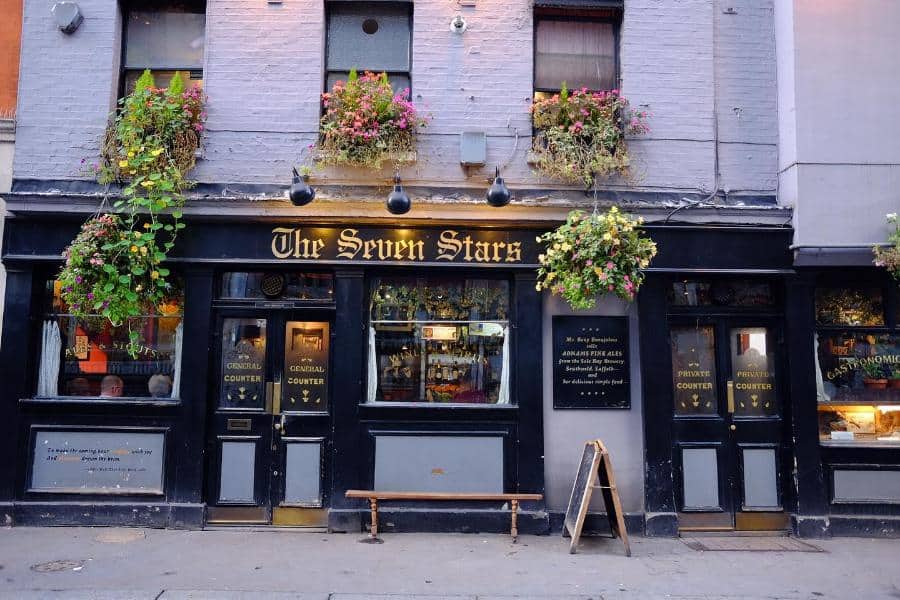London has a rich history of drinking establishments going back hundreds of years. Some of the oldest pubs and inns still serve beer today, while chronicling the life and times of past customers.
Alehouses and inns were first to emerge in the 12th century. Alehouses were for drinking beer and socialising, while inns additionally offered food and lodging to travellers. With the advent of coach travel, numerous coaching inns sprang up across the country, to offer hospitality.
By the Elizabethan era, taverns started to become more popular, as they were places to be seen. Taverns only sold wine and so appealed more to the professional classes, whilst alehouses remained the preserve of the working man.
Two of the pubs listed below, The Anchor and Ye Olde Cheshire Cheese, are two examples of London taverns that are still open today.
The Great Fire of London in 1666 caused the wholesale destruction of central parts of London. However undeterred, and within a year or two, building work was underway to rebuild the lost heritage.
The name public house was first used in the 17th century to describe an alehouse, tavern, or inn. These were literally public houses that anyone could visit, as opposed to private houses where people lived. The name ‘public house’ was eventually shortened to pub, which is still widely used today.
Oldest Pubs in London
The Seven Stars
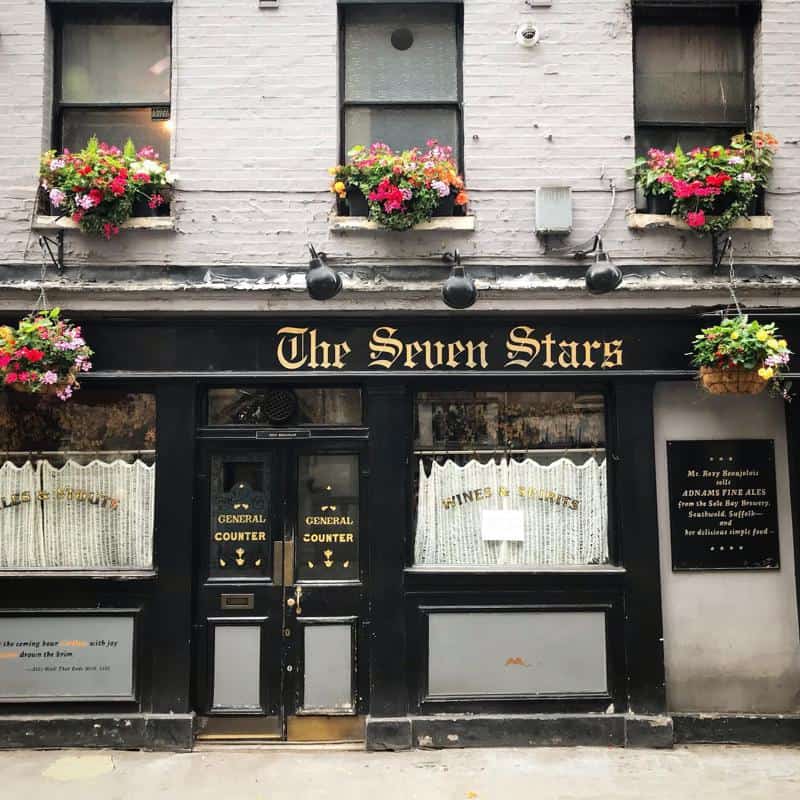
- Address: 53 Carey St, London WC2A 2JB
- Phone: 020 7242 8521
- Known for: The oldest pub in London and awards for the pub grub and drinks
If you want to start with one of the oldest and best pubs, then head to The Seven Stars, which faces the back of the Royal Courts of Justice in Westminster. Dating back to 1602, The Seven Stars was a survivor of the Great Fire of London which swept through the capital in 1666.
Shakespeare lived in London from 1608 to 1612 where he worked at the Blackfriars Theatre in Ludgate Hill only about half a mile from the pub. Could he have been an early customer popping in for a pint on his way home?
Well-kept beer and home cooking add to the ‘olde worlde’ charm without being twee.
The Old Bell Tavern
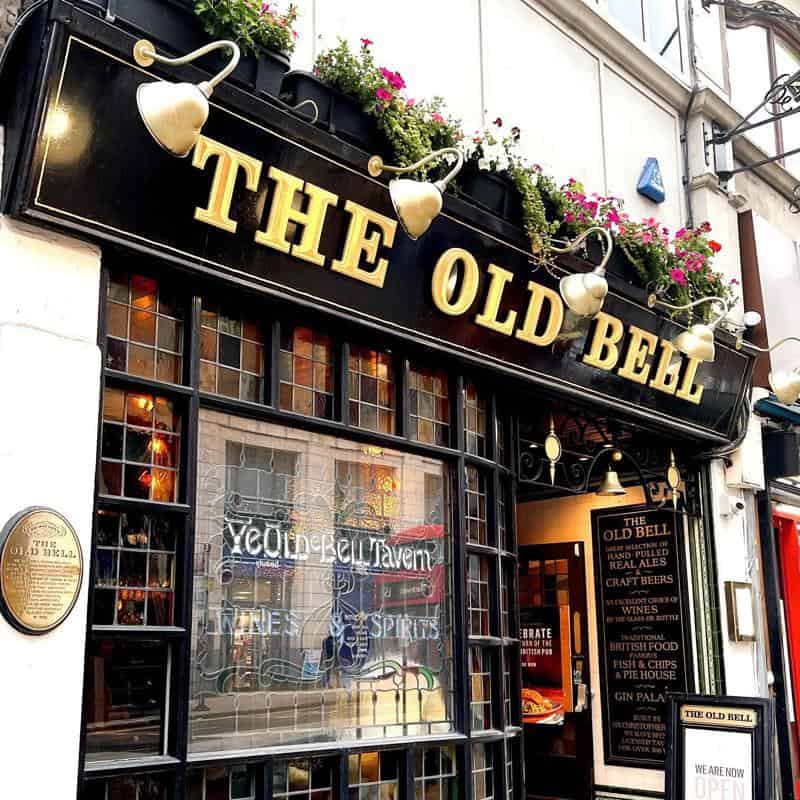
- Address: 95 Fleet St, Greater, London EC4Y 1DH
- Phone: 020 7583 0216
- Known for: Built by Christopher Wren and great pies
The Old Bell Tavern got off to a cracking start as it was built by Sir Christopher Wren the famous architect. At the time the building was lodgings for his masons, who were rebuilding St Bride’s Church after the Great Fire of London.
Wren is still celebrated for his other masterworks including St Paul’s Cathedral, Kensington Palace, and the Royal Observatory in Greenwich.
At one time the pub could only be accessed by an alleyway from Fleet Street. Here the first printing presses kick-started the information age in 1500.
The food at The Old Bell Tavern is hearty. Pies head up the menu, choose from Chicken and Mushroom or Wild Boar and Chorizo, all served with draught and cask ales.
Ye Olde Mitre
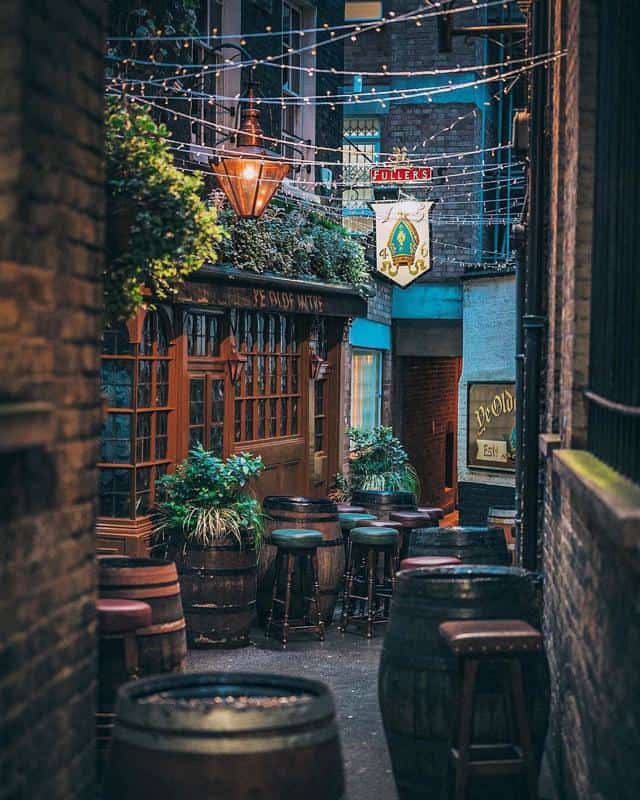
- Address: 1 Ely Ct, Ely Pl, London EC1N 6SJ
- Phone: 020 7405 4751
- Known for: Queen Elizabeth I dancing around the cherry tree outside
The Ye Olde Mitre pub is in Ely Court, a narrow passage that links Ely Place and Hatton Garden, the diamond trading centre. Originally built in 1546 by Bishop Goodridge of Ely the pub is famous for a cherry tree.
It’s documented that Queen Elizabeth I danced around the tree with Sir Christopher Hatton, who was a politician and close advisor to the Queen. In thanks for his work, he was given a house in Holborn, which led to the area being named Hatten Garden.
Ye Olde Mitre offers a range of toasted cheese sandwiches and snacks such as Scotch egg, porkpie, and sausage roll. The pub serves Fullers, among other draft beers.
Prospect of Whitby
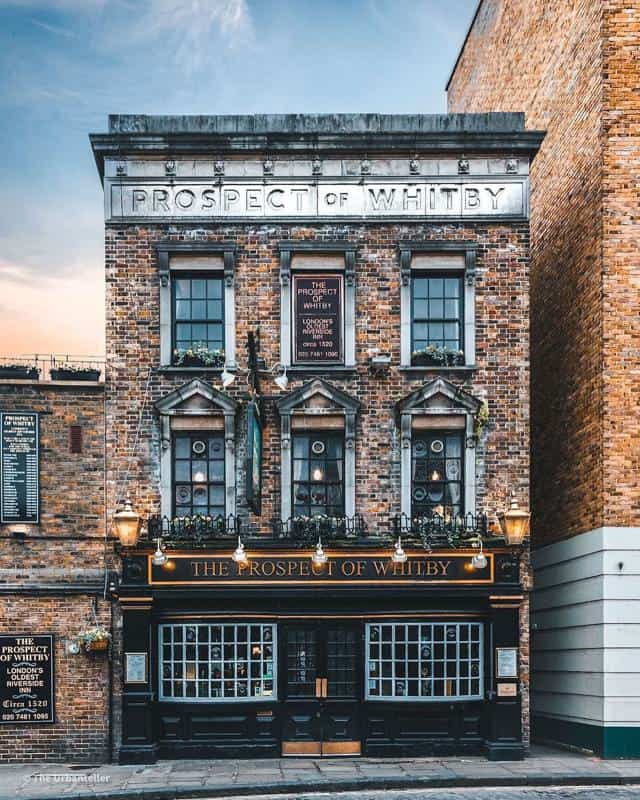
- Address: 57 Wapping Wall, London E1W 3SH
- Phone: 020 7481 1095
- Known for: Serving pirates and princesses
On a prominent riverside setting, the Prospect of Whitby has witnessed all manner of characters, who came to drink by the Thames. The pub’s name derives from a collier, who sailed coal from Newcastle and moored his ship, Prospect, nearby.
The dockside setting in Tower Hamlets attracted many dubious characters over the years, including smugglers, pirates, cutthroats, and robbers.
Inside the pub, there is the original 400-year-old stone floor, while on the walls, numerous local artefacts hint at the history of years gone by. These include pistols, clogs, Chianti bottles, skulls, ancient furniture, and copper kettles.
Famous patrons include Charles Dickens, Frank Sinatra, Princess Margaret, as well as British movie stars and politicians.
The Prospect serves toasties, snacks, and pub classics. Beverages include Greene King ales, wine, and spirits.
Ye Olde Cheshire Cheese
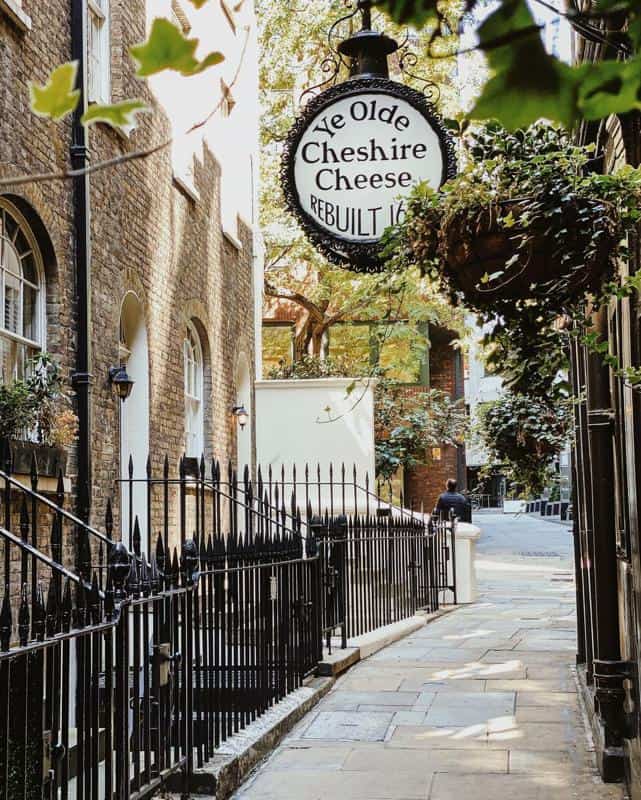
- Address: 145 Fleet St, London EC4A 2BP
- Phone: 020 7353 6170
- Known for: Literary associations. Patrons included Charles Dickens, G.K. Chesterton, and Mark Twain.
Tucked away on a side street in the City of London Ye Olde Cheshire Cheese has remained on the same site since it was built in the 1530s. Another casualty of the Great Fire of London the pub was quickly rebuilt in 1667 as a tavern.
The inside of the pub is entirely panelled in wood, much of it thought to date prior to the 19th century. There is little natural light inside from the windows and so with the subdued lighting, it is easy to understand how dim building interiors used to be.
The entire pub has wood panelling, much of it from before the 19th century. The pub layout is rambling, with bars and rooms dotted throughout. The ancient timbers have led to crooked doorways and mismatched steps.
There is a restaurant and chophouse serving English classics and beer courtesy of Sam Smiths.
The Lamb & Flag
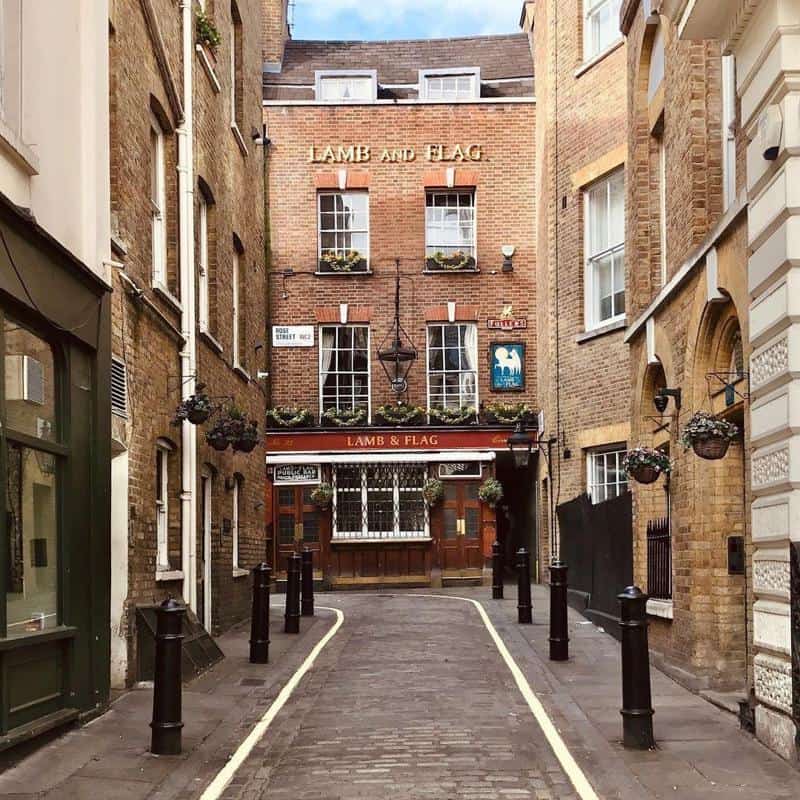
- Address: 33 Rose St, London WC2E 9EB
- Phone: 020 7497 9504
- Known for: Great for drinking outside and good beer
The Lamb & Flag was first recorded as licensed premises in 1772 when it was called Cooper’s Arms. Claims that the original pub goes back to 1623 are difficult to prove.
That said, The Lamb and Flag is a lovely pub to visit. The interior has lots of dark varnished wood, creaking staircases, brass fittings, and historical prints on the walls.
It wasn’t always so civilised. In the early 1800s, the back bar was called the Bucket of Blood, a reference to the bare-knuckle fights regularly held there.
It’s a very popular pub, especially when the weather is warmer when customers spill out onto the pavement and street in front of the pub. To eat, there is a sandwich and main menu, with English pub classics such as Fish Pie and Battered Haddock and Chips. Fullers offer their range of draught ales.
Also Read:
George

- Address: 75 Borough High St, London SE1 1NH
- Phone: 020 7407 2056
- Known for: The only surviving London gallery coaching inn
The George is a rare galleried coaching inn in Southwark just south of London Bridge.
It was built in 1677 with galleries on the first and second floor, which open out onto the paved courtyard.
In Elizabethan times galleried inns such as these were often used for theatre, where the actors would tell the story from the gallery to the audience down in the yard.
Charles Dickens was a fan of the pub and after visiting it he mentioned it in both Little Dorrit and Our Mutual Friends. Inside the pub, you will find many period features, wood beams, old wooden floors and numerous prints and paintings covering the walls.
With no passing traffic, the pub and courtyard are quiet areas to enjoy a drink.
The George is owned by the National Trust and leased to the pub owners.
The pub serves Greene King ales, along with sharing platters and snacks.
The Spaniards Inn
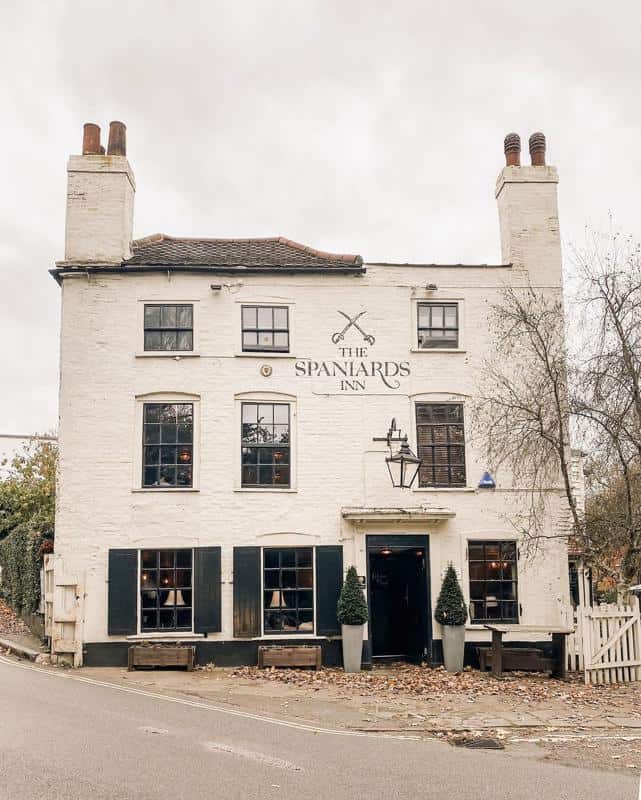
- Address: Spaniards Rd, London NW3 7JJ
- Phone: 020 8731 8406
- Known for: Legendary Sunday lunches and interesting history
When The Spaniards Inn was built in 1585, Spaniards Road was in the countryside on the edge of Hampstead Heath. Consequently, the inn was used by travellers on their way to London.
Not all of the passers-by had good intentions however and the Spaniards Inn became a haunt for highwaymen. Some even say that Dick Turpin’s father was the landlord for a time.
Over the years it has attracted numerous, famous literary characters including Byron, Keats, and Dickens. In fact, Dickens was so impressed he used the pub in The Pickwick Papers.
Visitors to the pub today can look through some of the memorabilia associated with these famous connections.
The menu is English European and pub classics, so you can choose between Roasted Garlic Chicken and Truffle Dauphinoise or Atlantic Cod and Chips.
Ye Olde Cock Tavern
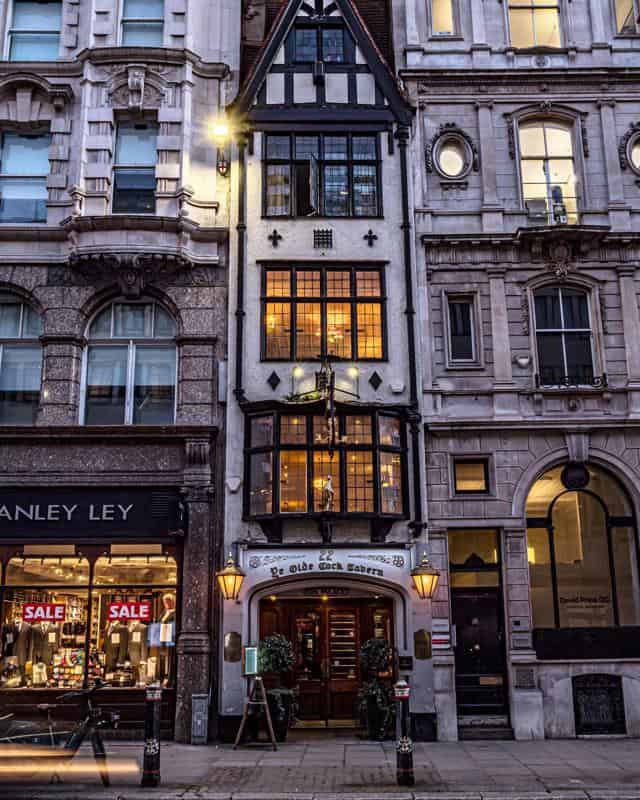
- Address: 22 Fleet St, Temple, London EC4Y 1AA
- Phone: 020 7353 8570
- Known for: Narrowest frontage of any London pub
On first impression with its slim frontage, it looks like Ye Olde Cock Tavern has been shoehorned in between larger buildings on either side. With mullioned windows and ornate lamps, the pub dates back to 1549.
However, dig a little deeper and you will find the Olde Cock has only been in its current site since 1887. Bizarrely, it was originally situated across the road, where it was then dismantled, transported to the other side of Fleet Street and rebuilt.
As with some other older London pubs Ye Olde Cock Tavern has attracted famous literary figures such as Charles Dickens, Doctor Johnson, and Samuel Pepys.
In fact, an entry in Samuel Pepys’s diary from April 23 1668 explains, ‘Samuel Pepys arrived at Ye Olde Cock Tavern by boat where he partook in beer and lobster.’
Expect Greene King draught ales, sharing platters, wings and fish and chips.
The Guinea Grill
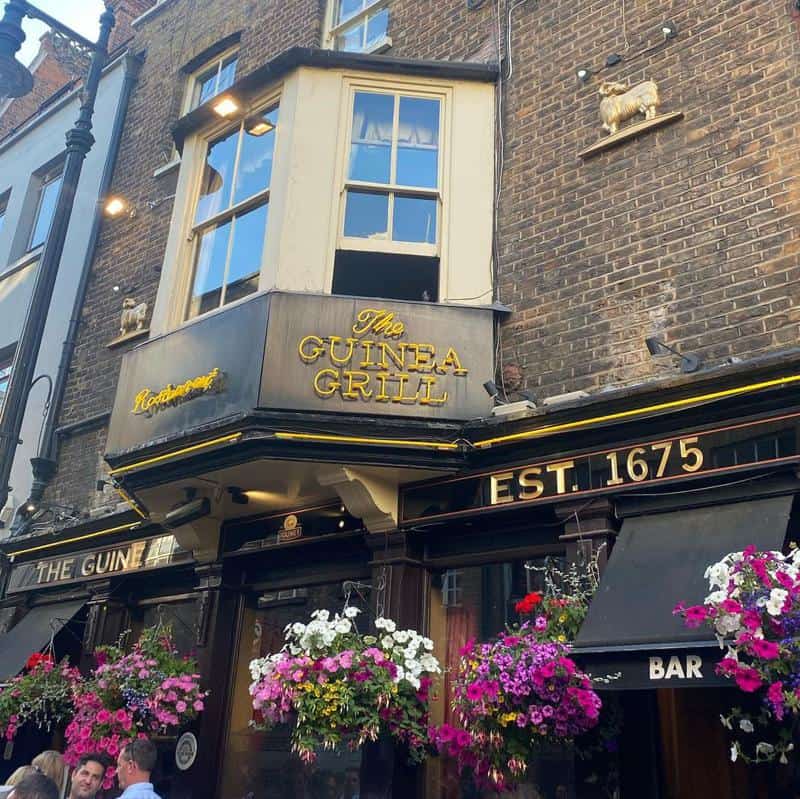
- Address: 30 Bruton Place, London, W1J 6N
- Phone: 0207 409 1728
- Known for: Being the three times national pie winner
There has been a pub on this site for more than 500 years. The Guinea is tucked away in Bruton Place, so you must keep your eyes open to find it. Inside you’ll discover wood panelling on which are hung pictures, caricatures, and cartoons. There is even a photo of Prince Charles, looking uncomfortable, as he pulls a pint of beer.
More memorabilia are showcased in the gents’ loo, with several autographs of stars of film and TV who were previous customers, including Bill Cosby, Mel Gibson, Bob Hope, Michael Douglas and even Graham Norton.
The Guinea is a gastro pub, with a European menu with mostly English dishes, such as award-winning pies and a mouth-watering selection of steaks. The wine list will keep enthusiasts happy, with some great examples of Bordeaux and Burgundy.
Also Read: Best Pubs in Mayfair, London
The Mayflower
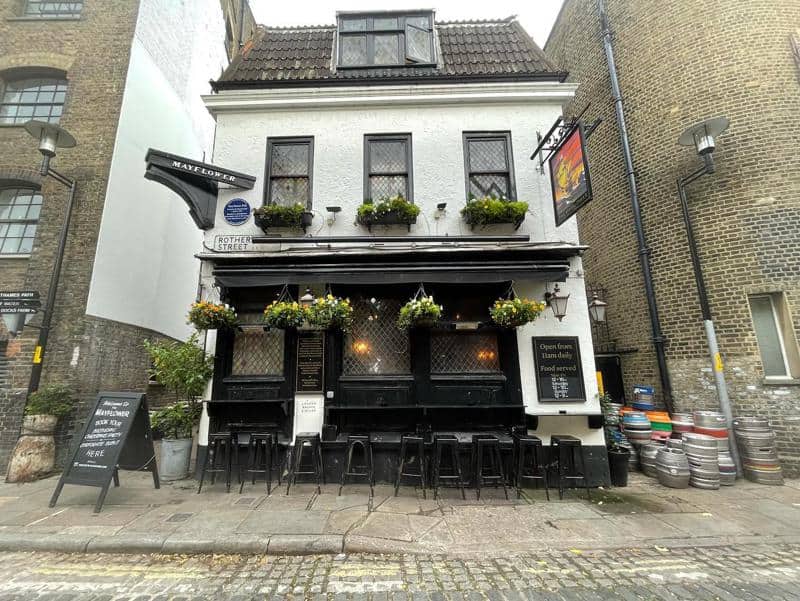
- Address: 117 Rotherhithe Street, Rotherhithe, London, SE16 4NF
- Phone: 020 7237 4088
- Known for: The departure of the ship The Mayflower to America
The Mayflower’s claim to fame is that the ship, the Mayflower, sailed from Rotherhithe, via Southampton to America on 6th Septembe1620. There were 102 passengers, Pilgrim Fathers, and 30 members of crew.
After a perilous journey they arrived in Cape Cod, north of their planned destination in Virginia on 11th of November 1620, after a journey of just over 2 months. The captain of the ship was Christopher Jones, a local Rotherhithe man.
He returned from America in May 1621 and died just over a year later. He is buried in nearby St. Mary’s church in Rotherhithe, which is close to the final mooring of the Mayflower, when her working life was finished.
Even today the Mayflower pub carries a weathervane on the roof in the shape of the Mayflower ship. With all its nautical connections the pub was originally known as the Shippe Inn in 1620 before it was renamed the Spread Eagle and Crown. The pub has only been named the Mayflower since 1957.
The Mayflower serves 14 draft beers and a selection of wines. The menu includes baguettes and European main courses, as well as traditional Sunday lunches.
The Grapes
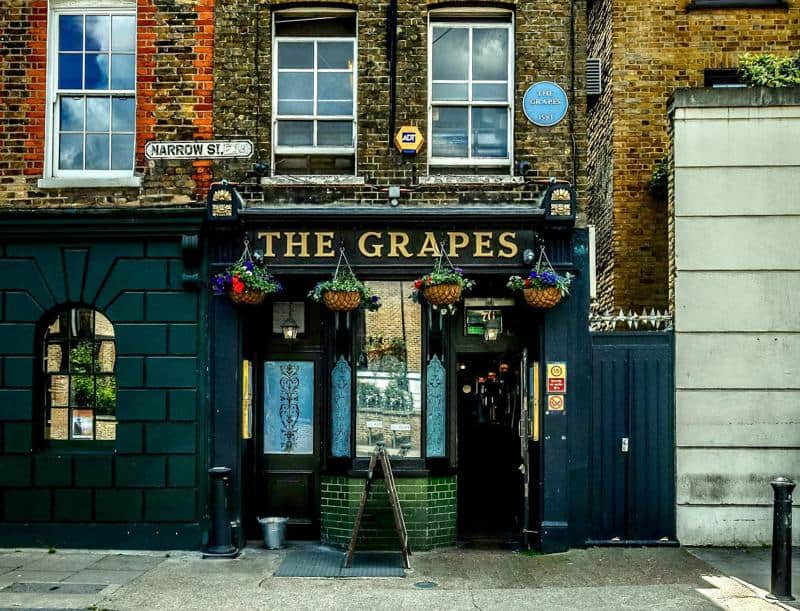
- Address: 76 Narrow Street, Limehouse, London, E14 8BP
- Phone: 0207 987 4396
- Known for: A complete set of Charles Dickens works in the back parlour.
Originally called the Bunch of Grapes, The Grapes has remained on the banks of pebbled Limehouse Reach for nearly 500 years.
In an area of riverside marshes, Limehouse was one of the few areas offering disease-free, dry land. It quickly became populated and was named after lime production, which took place in large lime kilns. In 1661, Samuel Pepys’ diary mentioned his trip to lime kilns at the jetty, just along from The Grapes.
Limehouse grew as a centre of commerce and by the beginning of the Elizabethan era it had become a centre of world trade. Queen Elizabeth I’s court explorer, Sir Humphrey Gilbert, lived in Limehouse and Sir Walter Raleigh departed on his third voyage to the New World from the same dockside.
Inside the pub has a Victorian long bar with plenty of wood panelling. From one of the rooms upstairs you can get expansive views of the Thames, with Canary Wharf, to the left and the City, to the right.
The Grapes offers a menu of mini-tapas and English main courses.
The Anchor
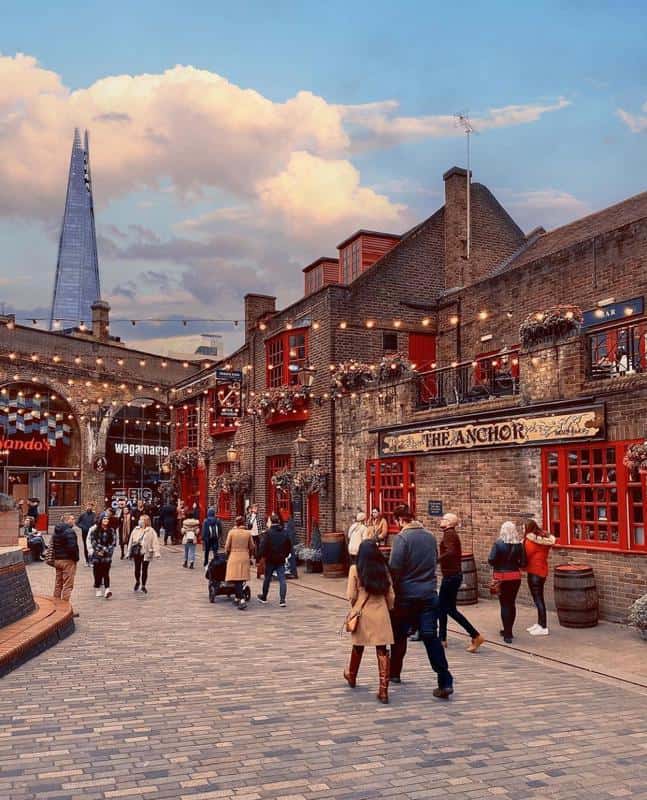
- Address: 34 Park Street, Borough, London, SE1 9EF
- Phone: 020 7407 1577
- Known for: Samuel Pepys saw the start of The Great Fire of London from here
The Anchor is located just back from the south side of the Thames between London Bridge and Southwark Bridge. It dates originally from the 1600s and is surrounded by modern day art establishments, such as Shakespeare’s Globe Theatre and the Tate Modern Gallery.
Samuel Pepys was a regular drinker at The Anchor, and he found refuge there by boat in 1666. He witnessed the Great Fire taking hold on the opposite side of the river. The pub displays a copy of Samuel Pepys diary.
Modernisation over the years has resulted in the loss of some of the historical features. However, the bars on the left-hand side as you go in retain most of the original architecture. The Anchor is a Greene King pub serving draught ales and pub classics.
Map of Oldest Pub in London
Final Thoughts
When the ages of some of the pubs we have put together for you are more than 500 years old it’s easy to understand the accuracy may sometimes be in question. Record-keeping all those years ago may not have been as precise, and the records themselves may not have survived.
However, the Great Fire of London in 1666 acted as punctuation, from which many pubs can be dated. As you visit some of the pubs you will be walking in the footsteps of some of the most celebrated characters in English history.
